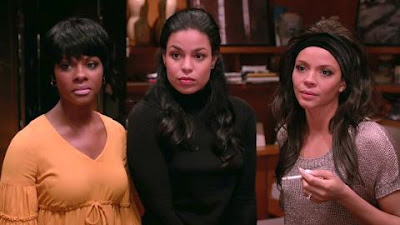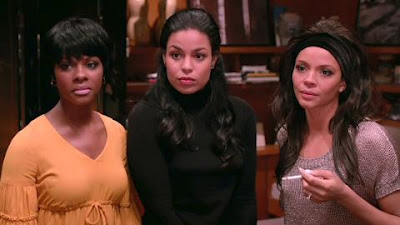 |
| The three sisters of ‘Sparkle’ (2012) |
Guest post written by Candice Frederick, originally published at Reel Talk. Cross-posted with permission.
 |
| Salim Akil’s Sparkle revisits the Motown era |
But right at the height of a promising career, life throws them some curve balls. Sister, always looking for the next quick and easy (and lucrative) opportunity, meets and falls hard for the “coon” comedian extraordinaire Satin (Mike Epps). She quickly gets entangled in his lies, deceit and utter immoralities and spirals downwards, taking her sisters’ singing group down with her. That is, until Sparkle finds the voice she’d kept hidden for so long, which will carry her to the next phase of her life and shine like she always dreamed she would.
 |
| Sparks as Sparkle in ‘Sparkle.’ Clear? |
Admittedly, Sparkle‘s storyline is the one cliched and predictable element carried over from the original movie. Sparks gives a fine performance but, like Irene Cara before her, doesn’t have much to work with and her real-life singing voice provides the most memorable scenes in her performance. What’s not so expected in this re-imagining is the heightened point of view of the other characters in the story. Emma, the girls’ mom, isn’t just a wise older woman with little dialogue but who dutifully captures the parental element of the story, as she is in the original film. Emma is now a very present mother in the story, someone who rules her house with a sharp but loving tongue, and one who is quick to recite passages from Scripture to remind her daughters of who’s really in control. Emma is also a “cautionary” character, as she herself alludes to but is careful not to define in the movie (as delivered in an eerily familiar and poignant performance by the late Houston). She is heavily nuanced and delicately penned by screenwriters Mara Brock Akil (TV’s Girlfriends and The Game) and Harry Rosenman (Father of the Bride, The Family Man).
 |
| The late Whitney Houston as mother Emma |
Also fine tuned for a razor-sharp performance is the role of Sister. She was always the most complicated character of the bunch, formerly played by the eternally underrated actress Lonette McKee (in one of her best roles). While Ejogo’s portrayal almost mirrors that of McKee’s (which is high praise), Sister doesn’t come across as similarly damaged as she did in the previous movie. She settles on a rather mature consequence for decisions she’s made, which in turn allows her character to linger just a bit longer here, and leave a lasting impression on the audience.
 |
| Sister, played by Carmen Ejogo |
Another unforgettable character portrayal is that of D played by Sumpter. If you’ve seen the original film, you might not even remember much of anything substantial about this third sister, except that she was her mother’s mute pride and joy. She was the one with the bright future whose feelings about the whole music thing is, as she further explains in this movie, are that she can “really take or leave it.” This remake does a better job at explaining a lot more behind her actions–i.e. why she’s more fearless than her other sisters in a lot of ways (she really has nothing here to lose) and why she won’t sacrifice everything for someone else’s dream. Sumpter, with help from the screenplay, gives D a backbone, a steel tongue to deliver the film’s wittiest and most entertaining dialogue that will cut through even the most dramatic scenes. Sparkle might have been the character in search of a voice, but it is D whose voice had become magnified and clearer.
| D, played by Tika Sumpter |
Epps also gives a surprisingly good performance here as well. And he’s got a lot to work with. Satin isn’t just the fleeting bad guy who comes to terrorize the Sister and her Sisters trio. He’s definitely not a guy you root for, but there is more to his story here. He has much more purpose. Epps sheds his comedic image to possibly play the role of his career, but uses some of that comedian swagger in a way that complements Satin’s own demons. Meanwhile, the other fellas in the cast, Luke and Omari Hardwick (who plays Levi, Sister’s jilted ex) contribute good–however serviceable–portrayals in an overwhelmingly female-driven movie.
———-

